Chełmno
Chełmno | |
|---|---|
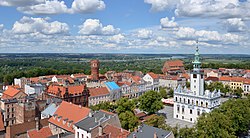 Chełmno Old Town with the Renaissance Town Hall on the right | |
 Flag  Coat of arms | |
 Chełmno | |
| Coordinates: 53°20′57″N 18°25′23″E / 53.34917°N 18.42306°ECoordinates: 53°20′57″N 18°25′23″E / 53.34917°N 18.42306°E | |
| Country | |
| Voivodeship | Kuyavian-Pomeranian |
| County | Chełmno County |
| Gmina | Chełmno (urban gmina) |
| Area | |
| • Total | 13.56 km2 (5.24 sq mi) |
| Elevation | 75 m (246 ft) |
| Population (2006) | |
| • Total | 20,388 |
| • Density | 1,500/km2 (3,900/sq mi) |
| Time zone | UTC+1 (CET) |
| • Summer (DST) | UTC+2 (CEST) |
| Postal code | 86-200 |
| Vehicle registration | CCH |
| Website | www.chelmno.pl |
Chełmno ([ˈxɛu̯mnɔ] (![]() listen); older English: Culm; German:
listen); older English: Culm; German: ![]() Kulm (help·info)) is a town in northern Poland near the Vistula river with 20,000 inhabitants and the historical capital of Chełmno Land. Situated in the Kuyavian-Pomeranian Voivodeship since 1999, Chełmno was previously in Toruń Voivodeship (1975–1998).
Kulm (help·info)) is a town in northern Poland near the Vistula river with 20,000 inhabitants and the historical capital of Chełmno Land. Situated in the Kuyavian-Pomeranian Voivodeship since 1999, Chełmno was previously in Toruń Voivodeship (1975–1998).
Name[]
The city's name Chełmno comes from chelm, the old Polish word for hill.[1][2] After the arrival of the Teutonic Knights in 1232 the Latin name Colmen was used. During the Middle Ages, the Germanized name Culm was used in official documents regarding the town, as the city was a member of the Hanseatic League and part of the State of the Teutonic Order.[3] Chełmno was annexed by Prussia in the First Partition of Poland in 1772 and, as part of a larger Germanization effort, it was officially renamed Kulm.[4] During the German occupation in World War II, the town was again renamed from Chełmno to Kulm.
History[]

The first written mention of Chełmno is known from a document allegedly issued in 1065 by Duke Boleslaus of Poland for the Benedictine monastery in Mogilno. In 1226 Duke Konrad I of Masovia invited the Teutonic Knights to Chełmno Land. In 1233 Kulm was granted city rights known as "Kulm law" (renewed in 1251), the model system for over 200 Polish towns. The town was made the nominal see of the Roman Catholic Diocese of Chełmno under the archbishop of Riga by the papal legate William of Modena in 1243 (however, the cathedral and the residence of the bishop were located actually in the adjacent Chełmża). The town grew prosperous as a member of the mercantile Hanseatic League. Kulm and Chełmno Land were part of the Teutonic Knights' state until 1454. In 1440, the town was one of the founding members of the Prussian Confederation, which opposed Teutonic rule,[5] and upon the request of which King Casimir IV Jagiellon reincorporated the territory to the Kingdom of Poland in 1454. In May 1454 the town pledged allegiance to the Polish King in Toruń.[6] After the end of the Thirteen Years' War, the Teutonic Knights renounced claims to the town, and recognized it as part of Poland. It was made the capital of Chełmno Voivodeship. After dissolution of the Archdiocese of Riga in 1566, the bishops of Chełmno attended the councils of the Ecclesiastical province of the metropolitan of Gniezno. This practice was recognised by the Holy See by the Bull De salute animarum in 1821, when Chełmno diocese became de jure a suffragan of the Archdiocese of Gniezno. Chełmno diocese was enlarged on that occasion (Górzno, Krajna and Działdowo). In 1692, the local gymnasium was transformed into the Chełmno Academy (Akademia Chełmińska), which in 1756 became a branch of the Jagiellonian University in Kraków, the oldest and leading Polish university.[7]
In 1772, following the First Partition of Poland, the city was taken over by the Kingdom of Prussia. Between 1807 and 1815 Chełmno was part of the Polish Duchy of Warsaw, being reannexed by Prussia at the end of the Napoleonic Wars.
As Kulm, it had been a garrison town. In 1776 Frederick the Great founded here a cadet school which was to serve in Germanising Polish areas and nobility.[8] In 1890 the garrison included 561 military staff.[9] On 1 October 1890 the cadet school was moved to Koszalin (then Köslin) in Farther Pomerania.[10] Also as part of anti-Polish policies, the Prussians expelled the Kraków professors from Chełmno,[7] abolished the local Polish academy, and closed down Catholic monasteries.[11] Poles were subjected to various repressions, local Polish newspapers were confiscated.[11]

Renown Polish surgeon Ludwik Rydygier opened his private clinic in the town in 1878, where he conducted pioneering surgical operations, including the first in Poland and second in the world surgical removal of the pylorus in a patient suffering from stomach cancer in 1880 and the first in the world peptic ulcer resection in 1881.[12] Rydygier sold the clinic to one of his employees, Leon Polewski, in 1887, due to harassment from the Prussian authorities.[12]
On January 22, 1920 Polish troops were greeted by a large crowd of residents and Chełmno was reintegrated with Poland, which regained independence after World War I.[11]
When World War II broke out in 1939, Nazi German authorities murdered 5,000 Polish civilians upon taking control of the territory.[13] The atrocities took place in Klamry, Małe Czyste, Podwiesk, Płutowo, Dąbrowa Chełmińska, and Wielkie Łunawy, while many other Poles were executed in forests.[13] The rest of the Polish population was expelled to the General Government in line with the German policy of Lebensraum. Polish Secret State resistance groups such as Polska Żyje ("Poland Lives"), Rota, Grunwald, and Szare Szeregi were also active in the area. The area was administered as part of Reichsgau Danzig-West Prussia and served as the seat of the district/county (kreis) of Kulm.
On 25 January 1945 German forces set fire to several buildings in the city, including a hospital, a railway terminal, and a brewery, while retreating (see scorched earth).
Demographics[]

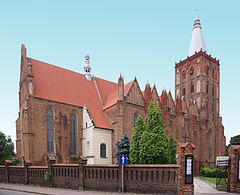
Since its founding, the city had a mixed population of Poles and Germans, with the former making ⅔ of its population in the second half of the 19th century.[4]
| Year | Inhabitants | Notes |
|---|---|---|
| 1843 | 5,000[14] | |
| 1890 | 9,762 | incl. 3,450 Protestants and 470 Jews.[9] |
| 1900 | 11,079 | together with the garrison, incl. 3,530 Protestants and 339 Jews.[10] |
| 1921 | 11,700 | incl. 1,060 Germans.[15] |
| 1969 | 18,000[16] | |
| 2006 | 20,388 |
Main sights[]
Chełmno has a well-preserved medieval center, with five Gothic churches and a beautiful Renaissance town hall in the middle of the market square.
The Old Town is one of Poland's official national Historic Monuments (Pomnik historii), as designated 20 April 2005, and tracked by the National Heritage Board of Poland.

- Gothic churches:
- Church of St Mary, former main parochial church of town, built 1280-1320 (with St. Valentine relic)
- Church of Saints James and Nicholas, former Franciscan church, from the 14th century, rebuilt in the 19th century
- Church of Saints Peter and Paul, former Dominican church, from the 13th and 14th centuries, rebuilt in the 18th and 19th centuries
- Church of Saints John the Baptist and Johns the Evangelist, former Benedictine and Cistercian nuns' church, with monastery, built 1290-1330
- Church of Holy Ghost, from 1280–90
- Town hall, whose oldest part comes from the end of the 13th century, rebuilt in manneristic style (under Italian influence) in 1567-1572
- City walls which surround whole city, preserved almost as a whole, with watch towers and Grudziądzka Gate
- Arsenal building constructed in 1811, now the seat of public library in Chełmno
- Baroque building of the Chełmno Academy, reconstructed in the 19th century
- Park Planty
- Monument of Ludwik Rydygier
Chełmno gives its name to the protected area called Chełmno Landscape Park, which stretches along the right bank of the Vistula.
Notable residents[]

- Brunon Bendig (1938–2006), amateur boxer
- Adam Cieśliński (born 1982), footballer
- Friedrich-Carl Cranz (1886–1941), general
- Hans Dominik (1870–1910), colonial officer
- Roderich von Erckert (1821-1900), ethnographer
- Friedrich Fülleborn (1866–1933), physician and tropical disease specialist
- Heinz Guderian (1888–1954), German general, blitzkrieg and tank theorist
- Wojciech Stanisław Leski (1702–1758), Bishop of Chelmno
- Hermann Löns (1866–1914), writer
- (1890–1914), writer
- Michael Otto (born 1943), entrepreneur
- Franciszek Raszeja (1896–1942), doctor
- Leon Raszeja (1901–1939), lawyer
- (1889–1939), theologian
- Ludwik Rydygier (1850–1920), renown surgeon and professor of medicine
- Antoni Grabowski (1857–1921), chemical engineer, Esperanto activist
- (1882–1975), Jewish rabbi
- Walter Schilling (1895–1943), Wehrmacht general
- Kurt Schumacher (1895–1952), politician
- Max Sperling (1905–1984), Wehrmacht officer
- Max Stirner (1806–1856), philosopher
- Adolf Wach (1843–1926), German jurist
- Jakub Zabłocki (1984–2015), footballer
Gallery[]

Chełmno Market Square

Saints James and Nicholas church

Historic townhouses at the Market Square

Historic townhouses in the Old Town
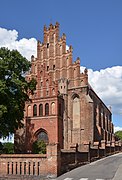
Saints Peter and Paul church

Garrison Church of Our Lady of Częstochowa

Grudziądzka Street in the Old Town

Grudziądzka Gate
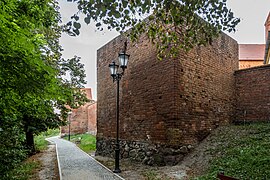
Defensive walls
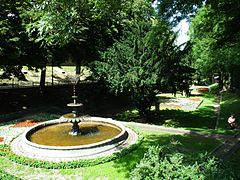
Planty Park
High school

Post office

Water tower
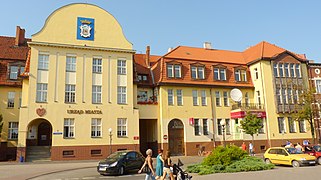
Municipal office
See also[]
References[]
- ^ Acta Universitatis Nicolai Copernici: Nauki humanistyczo-społeczne, Issues 22-28 Uniwersytet Mikołaja Kopernika, 1967, page 6
- ^ Słownik etymologiczny nazw geograficznych Polski Maria Malec Wydawn. Naukowe PWN, 2002, page 56
- ^ Heinrich Gottfried Philipp Gengler: Regesten und Urkunden zur Verfassungs- und Rechtsgeschichte der deutschen Städte im Mittelalter, Erlangen 1863, pp. 679-680.
- ^ Jump up to: a b Hargreaves, Richard (2009). Blitzkrieg w Polsce - wrzesień 1939. Warsaw: Bellona. p. 29.
- ^ Górski, Karol (1949). Związek Pruski i poddanie się Prus Polsce: zbiór tekstów źródłowych (in Polish). Poznań: Instytut Zachodni. p. 11.
- ^ Górski, p. 76
- ^ Jump up to: a b Mateusz Załuska. "Akademia Chełmińska". Zabytek.pl (in Polish). Retrieved 22 August 2021.
- ^ Polacy i Niemcy wobec siebie Stanisław Salmonowicz, Ośrodek Badań Naukowych im. W. Kętrzyńskiego, 1993
- ^ Jump up to: a b Brockhaus Konversations-Lexikon. 14th edition, vol. 4, Berlin and Vienna 1892, p. 624-625 (in German).
- ^ Jump up to: a b Meyers Konversations-Lexikon. 6th edition, vol. 11, Leipzig and Vienna 1908, p. 785-786 (in German).
- ^ Jump up to: a b c "Chełmno w dniu odzyskania niepodległości 22 stycznia 1920 roku". Chelmno.pl (in Polish). Retrieved 13 April 2020.
- ^ Jump up to: a b Stanisław Marian Brzozowski. "Ludwik Rydygier". Internetowy Polski Słownik Biograficzny (in Polish). Retrieved 13 April 2020.
- ^ Jump up to: a b Institute of National Remembrance data, based on Leszczynski, Kazimierz "Eksterminacja ludności w Polsce w czasie okupacji niemieckiej 1939-1945", Warsaw, 1962
- ^ Universal-Lexikon der Gegenwart und Vergangenheit (H. A. Pierer, ed.). 2nd edition, vol. 17, Altenburg 1843, p. 51 (in German).
- ^ Der Große Brockhaus. 15th edition, vol. 4, Leipzig 1929, p. 297-298 (in German).
- ^ Meyers Enzyklopädisches Lexikon. 9th edition, vol. 6, Mannheim/Vienna/Zürich 1972, p. 122 (in German).
| Wikimedia Commons has media related to Chełmno. |
External links[]
- "Shoah (Film) Interview with Gustav Laabs" - Interview
- Cities and towns in Kuyavian-Pomeranian Voivodeship
- Chełmno County
- Pomeranian Voivodeship (1919–1939)
- Kulm law
- Nazi war crimes in Poland
















